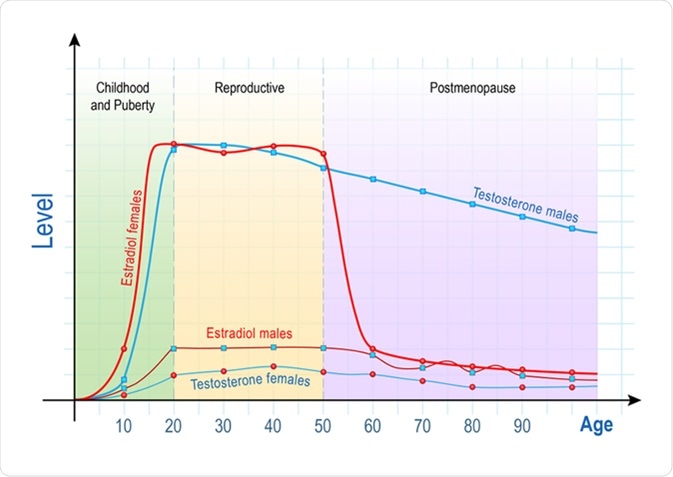What is estradiol and how does it work?
Estradiol is a female sex hormone required for the normal development and functioning of the reproductive system. The hormone also plays a vital role in maintaining the health of other tissues such as bone.
Estradiol is an estrogen steroid hormone derived from the cholesterol molecule. During the reproductive period, the granulosa cells in the ovaries produce estradiol from androstenedione. Minor quantities are produced in the adrenal gland, fat cells, the brain, arterial walls and placenta. In men, the testes produce a small amount of estradiol, which is important in erectile function, sperm maturation and modulating libido.

Estrogen action. Oestrogen, or estradiol is the primary female sex hormone. Woman silhouette with highlighted internal organs - Image Credit: Designua / Shutterstock
Mechanism of action
Estradiol binds to specific receptors in the target cell, and subsequently enters the nucleus to induce the formation of messenger RNA. The messenger RNA then interacts with ribosomes to produce specific proteins that exert estradiol effects on the cell.
Functions of estradiol
Some important functions of estradiol include:
1. Reproduction
Estradiol is the primary hormone responsible for the development and growth of key female reproductive structures such as the vaginal lining, the fallopian tubes, the uterine endometrium and the cervical glands. It also conserves the eggs or oocytes in the ovary and is a key component in ovulation and pregnancy implantation.
2. Development of secondary sexual characteristics
Estradiol is responsible for the development of secondary sexual characteristics or bodily features that appear during puberty. These include breast development, changes in body shape, bone growth and fat deposition.

Chart of Sex hormone production in humans. Image Credit: Designua / Shutterstock
3. Role in maintaining pregnancy
Estrogen helps maintain pregnancy and stimulates fetal maturation.
4. Estradiol in bone health
Estradiol is essential for optimal bone growth and for healthy bones and joints. Osteoporosis, a bone disease characterized by loss of bone density, can occur with low estradiol levels. Bone loss is more common following menopause because of the low serum estradiol levels.
5. Neuroprotective effects
Estradiol also exerts protective effects in the central nervous system, with relation to spinal cord trauma, ischemic brain injury and traumatic brain injury.
6. Effects on blood flow
Estrogens affect the vasculature and improve blood flow in the coronary arteries.
7. Oncogenic nature
Emerging research suggests that estrogen activates cancer-causing genes (oncogenes), which increase the risk of breast cancer and endometrial cancer. Some forms of breast cancer are estrogen-dependent, and drugs such as gonadotropin-releasing factor agonists, aromatase inhibitors and estrogen antagonists are used to block estradiol effects in these tumors. Estrogens have also been linked to several non-cancerous conditions such as endometriosis, uterine fibroids and abnormal uterine bleeding.
Estradiol Treatments
Various conditions characterized by low blood levels of estradiol are treated with this hormone, such as:
Hormone replacement therapy (HRT)
Estradiol levels fall at menopause or after oophorectomy (surgical removal of the ovaries). This causes severe side effects such as hot flushes, vaginal dryness, abnormal vaginal bleeding and pain, and itching around the vagina. Estradiol deficiency also causes psychological problems like depression, anxiety, mood swings and irritability. Hormone replacement therapy, which combines estradiol and progesterone, is used to treat these bothersome symptoms.
Infertility treatment
Estradiol helps to maintain the uterine lining for implantation and ensure sperm-friendly cervical mucus. It also helps to sustain pregnancy
Contraceptive
Estradiol is a component of the combined oral contraceptive pill, used for birth control as well as to treat disorders such as menorrhagia, irregular menstruation and polycystic ovary disease (PCOD).
Transgender hormone therapy
Estradiol is used to maintain female characteristics in male-to-female transsexuals.
Estradiol Metabolism
Most of the estradiol in the blood binds to proteins such as globulin and albumin. Only a small fraction of estradiol exists as free or active estradiol. The free form is metabolized in the liver and converted to less active estrogens - estrone and estriol. Estriol is the main urinary estrogen metabolite.
Estrogen is available in a variety of formulations such as pills, transdermal patch, creams, ointments, injections, douches and pessaries. Oral estradiol is not readily absorbed in the gut. This may reduce the therapeutic effect and increase the risk of adverse reactions. To reduce this, estrogen formulations for skin and vaginal application have been devised to deliver estradiol to the body.
What causes low estrogen levels?
Estradiol levels fluctuate over time, and reliably indicate some fertility problems or alterations in ovarian function. The level dips briefly during ovulation and peaks again during the luteal phase or the latter half of the menstrual cycle. In the absence of pregnancy, the level falls to its lowest at the end of the luteal phase. If conception occurs, estradiol levels rise steadily until the fetus is mature.
Some of the reasons for low estrogen levels include:
- Hypopituitarism
- Perimenopause and menopause
- Hormonal problems such as polycystic ovarian syndrome
- Anorexia and low body fat
- Rigorous exercise
- Medications that block estrogen
- Childbirth and breastfeeding
Estradiol/Estrogen, What Is The Benefit?
How are estrogen levels measured?
Measuring estrogen levels can provide essential information regarding fertility, pregnancy, menstrual cycle, and other health conditions. Estradiol levels vary throughout a women’s menstrual cycle. After menopause, it drops to a very low but constant level.
Direct radioimmunoassays
Direct radioimmunoassays were the earliest method of estrogen measurement, and have a detection limit of 30-100 pg/ml.
Liquid chromatography-tandem mass spectrometry
Liquid chromatography-tandem mass spectrometry (LC-MS/MS) can detect estradiol levels to as low as 10 pg/ml; however, it poorly reflects the normal distribution of values with low mean estradiol concentrations. This can cause clinical difficulty as a displayed value of 10 pg/ml could indicate a real value of between 10 and 60 pg/ml, for instance.
Isotope dilution gas chromatography-MS
Isotope dilution gas chromatography-MS is the gold standard for estradiol measurement; it is, however, cumbersome, slow and requires precise calibration, with zero interference. It is presently ill-adapted for routine clinical use. Efforts are being made to develop this method for more ease and rapidity.
Some applications of estradiol assays include:
Amenorrhea
Estradiol levels in amenorrhea can help to diagnose menopause or underlying disorders of the reproductive system.
Fertility issues
During infertility treatment, estradiol levels are crucial to maintain the hormonal balance required for ovulation, preparation of the endometrium and implantation of the fertilized ovum.
Pregnancy-related conditions
Estradiol monitoring may help predict the risk of complications associated with molar pregnancies, and of flare-ups of systemic lupus erythematosus in pregnancy in women.
Cancer management
Estradiol level measurements help in the management of breast cancers and prostate cancer. For instance, they help monitor anti-androgen therapy in prostate cancer. High estradiol levels in postmenopausal women indicate an increased risk of breast cancer.
Precocious puberty
Precocious puberty refers to pubertal development at an age earlier than is considered normal. The condition is characterized by high estradiol, and estradiol measurements are key to assessing the response to therapies such as gonadotropin-releasing hormone agonists.
Side effects of estradiol
Estradiol therapy may cause adverse effects such as:
- Abnormal vaginal bleeding
- Painful periods or dysmenorrhea
- Fibroid enlargement
- Vaginal infections such as candidiasis
- Changes in the amount of vaginal secretion
- Cervical ectropion or erosion
- Galactorrhea or the spontaneous flow of milk from the nipple when a woman is not nursing
- Nipple discharge
Drug interactions
The following are some of the most severe drug interactions of estrogen:
Estradiol and warfarin – Estradiol increases warfarin metabolism, thus impairing its efficacy.
Estradiol and tranexamic acid - Tranexamic acid is used to treat menorrhagia. In a woman on estradiol, it may increase the risk of thrombosis.
Anti-aromatase agents and estradiol - Anti-aromatase or aromatase inhibitors are used to lower estrogen levels in breast cancer, and do not work well if combined with estrogen.
Cosyntropin – Cosyntropin levels are used to screen for adrenocortical insufficiency. Estrogen metabolites may interfere with cosyntropin assays.
Estrogen and lamotrigine – Estrogen increases lamotrigine metabolism, which, in turn, decreases lamotrigine efficacy.
Additionally, moderate drug interactions occur with rifamycins, St. John's Wort, thyroid preparations, selected human immunoglobulins, raloxifene, certain anticonvulsants and corticosteroids.
Natural ways to boost estrogen levels
Estrogen levels in the body can be boosted by foods rich in phytoestrogen (plant-based estrogenic compounds) and isoflavones. Flax seeds are among the richest sources of phytoestrogen, as are strawberries and peaches. Soy products contain isoflavones, while nuts provide both phytoestrogens and isoflavones.

Flax seed and flax flower - Image Credit: Volosina / Shutterstock
Maintaining appropriate body weight is also important in increasing estrogen levels, as being underweight can impair estrogen production and cause menstrual irregularities.
Further Reading